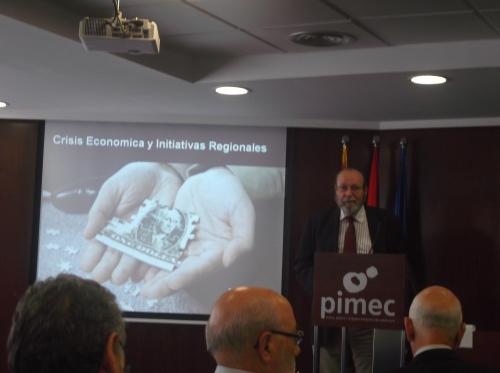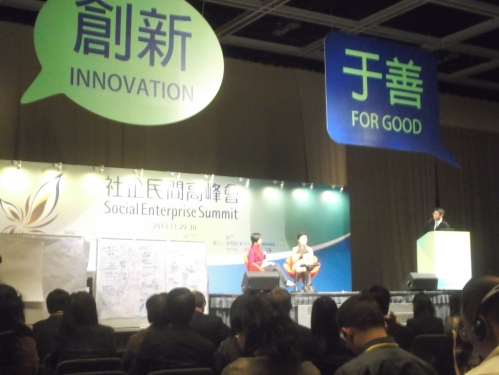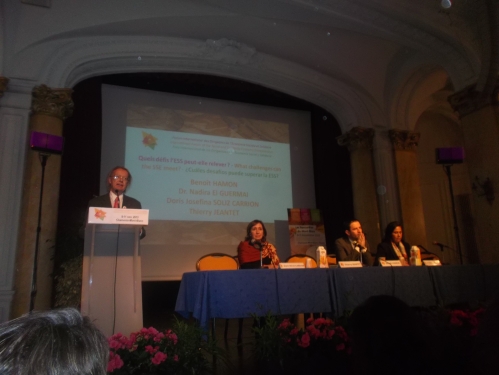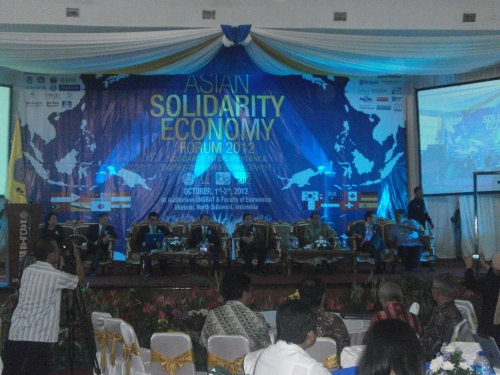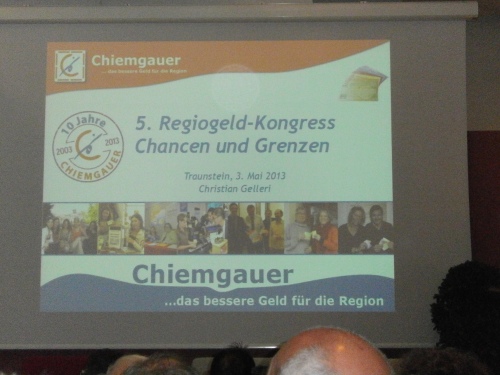
A congress in commemoration for the 10th anniversary of Chiemgauer took place from 03rd to 05th May 2013 and at Traunstein, Upper Bavaria, Germany. Some 200 people joined from different parts of Germany, Austria, France, Hungary, Italy, Japan, Spain (me) and the Switzerland to discuss on complementary currencies.
Chiemgauer started in January 2003 as an initiative at a Waldorf school (a private school under its own educational guideline proposed by the anthroposopher Rudolf Steiner) and is an euro-backed currency. Each one chooses a social or environmental project on becoming a member, exchanges euro into this regional currency in parity (100 € > 100 Chiemgauer), pays at local businesses which accept Chiemgauer and 3% of his/her expenditure goes to this social or environmental project. Businesses can spend it at other local businesses or redeem euro with 5% of commission (100 Chiemgauer > 95 €) and the non-profit Chiemgauer pays its administration costs with the rest of 2€. This regional currency works at two counties (Landkreise) of Rosenheim and Traunstein, on top of the Rosenheim City which is out of the homonymous county, and 651 local businesses and 262 projects join this system, with 703,332 Chiemgauer in circulation (as of May 2013). Its statistics say that in 2012 there were 2,573 consumers, the member businesses’ annual turnover is 6,452,279 Chiemgauers, e55,934 € was donated to social projects and this social currency circulates 11.22 times per year, in other words 2.78 times quicker than euro, stimulating the regional economy.
The congress started with the presentation by Christian Gelleri, Chiemgauer’s founded, titled as “Chancen und Grenzen” (Chances and Limits). He made clear that by using this complementary currency members want to “determine democratically about the money”, “give money its homeland”, “keep money in circulation” and “money to promote dialogue and actions”, with the aim to achieve the “consciousness on the money and the economy”, “as much value creation as possible as far as they correspond to our needs and the Mother Nature allows us” and “as much donation as possible to the culture, to the education and to the art”. He showed the message by the Horst Köhler, former President of the Federal Republic of Germany, who evaluates positively Chiemgauer, as “such regional currencies allow people to see the money system as something significant of our social environment and of our homeland”, and this former head of German state underlines too the fact that people learn the origin of money and that the environmental and social sustainability should be much more easily visualized. Then he pointed out seven limits and seven chances.
Limits
• Emotionality of money (people’s fear to touch the money issue)
• Mist on the money (the lack of understanding on its true function)
• Bureaucracy and old laws
• Gap between theory and practice
• Critical mass
• Power and resources
• Infulence of the huge system (euro etc.) on the small ones
Chances
• De-emotionalisation of the money
• Demands, as customers rule
• Use of Chiemgauer “All the members live Chiemgauer”
• Partial payment of salary in regional currency
• Synchronisation of the donation with regional currencies
• Creative management of the regional currency
• Introduction of Chiemgauer in crisis-hit regions
The Day 2 (Sat, 04th May) started with the keynote speech by Dr. Prof. Margrit Kennedy, author of important books on the money, such as “Inflation and Interest-free Money”, “People Money” and “Occupy Money”. Her presentation, titled as “Euro and Chiemgauer: An almost objective comparison between two different brothers”, began with showing five unsustainable aspects of our current money system, i.e.:
• It creates economic booms and busts
• It churns out short-term-minded thoughts
• It requieres endless growth
• It concentrates the wealth
• It smashes the social capital
And then she showed six solutions for the current crisis on the basis of recently published books.
1. Canncellation of debts (such as Jubilee), by US professors Michael Hudson and David Graeber
2. Abolition of euro and restoration of money sovereignty for each Eurozone country (Prof. Joachim Starbatty)
3. Chicago Plan and “Full Money” (by International Monetary Fund and many others): to allow financial institutions to give new credits only when they have the same amount of cash reserve.
4. Complementary currencies in permanent circulation in harmony with the environment (Charles Eisenstein)
5. How can we set ourselves free from our understanding on the property and money and, among others interest (Christian Kreiß)
6. The introduction of complementary currencies can solve social, ecological and cultural issues without new taxes nor laws (Bernard Lietaer, Christian Arnspenger, Stefan Brunnhuber and Sara Goerner)
Another important fact illustrated by this professor is that, had the Article 25 of the French Law of 03rd January 1973 on the Banque de France not been put into effect, the French government would have saved 1.306 trillion euros for interest payment and that the percentage of public debt in France would be ony 8.3% of its GDP, on top of another graphic to show the correlation between the exponential growth of goods and debts in the public sector, private businesses and individuals.
Dr. Prof. Kennedy highlighted the importance to implement complementary currencies at different levels (local / regional / national / international / global) and for different goals (timebanks for the elderly care, health currency, educational currency and energy currency), telling the experiences of WIRBank (Switzerland), RES (Belgium and Catalonia (Spain)), social currency at Gent (Belgium) to help immigrants cultivate urban farms and that of Zurich (the Switzerland) for a farmers’ cooperative. She also explained the difference between the demurrage currency (a family with 6,000 € of cash at hand loses 300 € per year) and the inflation (a family with 200,000 € of saving loses 10,000 € per year in case of 5% of inflation) and she proposed the application of the Chiemgauer model to implement a national currency in countries such as Greece and Spain on the basis of euro reserve (see here the proposal) . And she concluded by showing the difference between complementary and conventional currencies:
Complementary currency / Conventional currency
- Generates (social) utillities / Generates (monetary) profits
- Limited use / Universal usl
- Charges fees / Charges interests
- Transparent creation / Not transparent creation
- Strengthens communities / Weakens communities
- Softens inflations / Stimulates inflations
- Backed with services / Backed with properties
- Benefits for everybody / Benefits for 10% of the population
Then four parallel workshops took place, i.e.: “Regional Currencies and Banks”, “Post-Growth Economy”, “Chiemgauer for Beginners” and “the Miracle of Wörgl”. I was at the Post-Growth Economy where Nico Paech, from Ossietzky Oldenburg university, criticised the general view on the Green economy which optimistically thinks that technological innovations will solve all environmental and economic issues, questioning the conventional paradigm of the obligation to the growth and suggesting the post-growth economy as that of sufficiency, subsistence, regional economy, “new” production and institutions. He also showed the fact that the need to work more hours diminished the time available for consumption (Why do you work more and earn more if you have no time to spend?) and proposed the transition from large production chains (global and commercial economy) to the subsistence (local and non-commercial economy) and to prosumers’ economy.
In the afternoon eight workshop took place, four just after the lunch and other four subsequently. The first four were titled: “Regional currency and tourism”, “The euro crisis”, “Diversity of money instead of monoculture” and “Chiemgauer for the advanced”. I was at the diversity session where Mr. Franz Jansky mapped different initiatives in Germany and some neighbouring counties (Austria, Luxembourg, Netherlands and the Switzerland). An interesting tendency was observed that in the former East Germany, impoverished regions where many Neonazis emerge, the non-euro-backed model is prevailing, perhaps due to the lack of euro while in Upper Bavaria, another affluent region with many experiences, the regional currencies tend to be backed with euro. He also warned that an adequate language should be used to avoid the misunderstanding that complementary currencies have racist goals in regions with many Neonazis.
And later other four sessions took place: “regional currency and communities”, “regional currency as a social innovation tool”, “rethink the economy for a new economic culture in businesses and society” and “Momo, Faust and Co., Vision of a better money in arts and literature”. I was at the session of social innovation where Dr. Prof. Margrit Kennedy answered different questions in this respect, such as: the crisis can stimulate the promotion of social currencies (ex.: Barter clubs in Argentina), the social bond is needed to create the trust to the social currency, it is necessary to involve appropriate stakeholders to promote social currencies and that it’s necessary to learn from experiences in other countries (Brazil, Japan and New Zealand), among others.
The conference finished with another presentation by Niko Paech which talked once again on the Post-Growth economy. He explained that the current consumerist society, based on the looting of natural resources, is unsustainable due to the time limit (today I own and later I’ll pay), to the physical limit (such an economy is possibly only because of energy waste) and to the space limit (global production chain). He underscored the importance of sufficiency (the sustainability deficit without welfare trigger impoverishment) and of subsistence (environmental damage by the external supply cannot be eliminated by its own systemic logic). He explained the obligation to grow from the supply’s viewpoint (the necessary amount of surplus increases as the specialised production chain is advanced) and from the demand’s one (the idea of freedom is quite closely related with the permanent increase of material realisation) and he showed proposals for both aspects (for the supply setup of cooperatives, monetary reform and reduction of the financial need and for the demand: soften or turn off the driver for consumption).
A very interesting fact that I’d like to highlight is the strong regional identity which seemed to have a lot to do with complementary currencies in my opinion: at Upper Bavaria (especially at the Alpine region between Munich and Salzburg) people are really attached to their land and some hotels and restaurants have employees in traditional costume. It’s true that the natural beauty if this region is impressive and it’s quite natural that locals should be proud of their land. In Spain where I currently live, Catalonia and Euskadi (“Bask Country”) have more social currencies than others, perhaps also due to people’s strong identity with the land, although culturally these places are different (Bavarians are very conservative while Catalans and Basques tend to be innovative, in my opinion).
It might be true that the identity plays an even more important role than people’s orientation for social innovation in terms of the implementation of complementary currencies: In Germany Berlin is known to be the place with many people into alternatives, but there complementary currencies don’t work because of the lack of local identity. I thought that people’s political tendency had a lot to do with the success of complementary currencies, but it seems like the local identity is more important…

